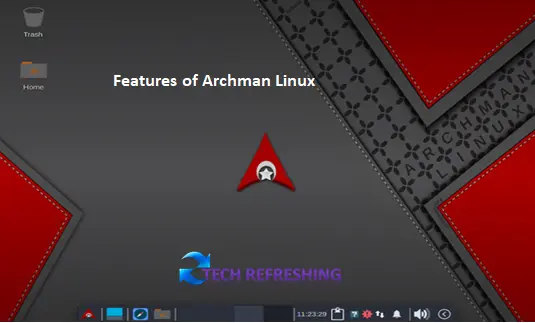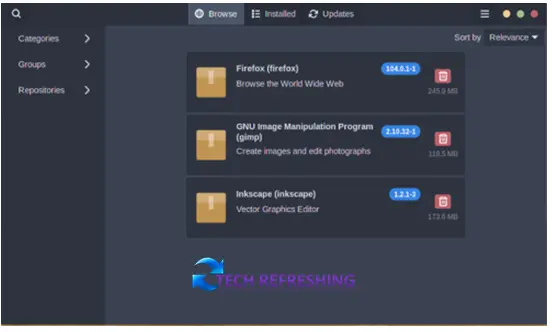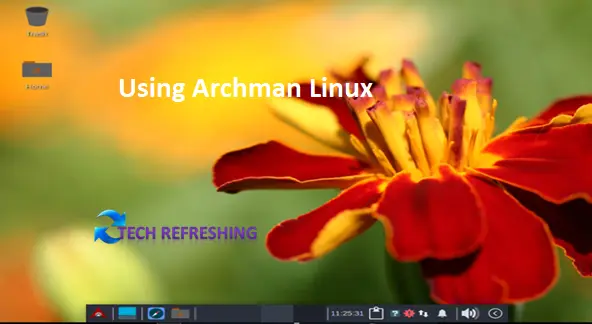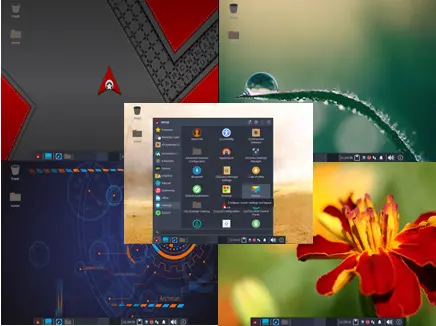Archman Linux is a Linux operating system that is built on the foundation of the well-known Arch Linux distribution. It follows a rolling release model that entails regular updates and enhancements to keep the system current. Archman Linux is designed to be swift, lightweight and extremely adaptable, making it a favored option for power users and developers.
A group of volunteers who work together to maintain and advance the distribution produce Archman Linux. Because it is a free and open source operating system, anyone can download, use and alter it anyway they see fit.
Brief Overview of the Topics Covered in the Post
In this article, we aim to offer a comprehensive account of Archman Linux. Our exposition will begin by delving into the history of Archman Linux and its progression over time. Subsequently, we will elaborate on the salient features of Archman Linux, including its package management system, rolling release model, and lightweight design.
Furthermore, we will delve into the advantages of utilizing Archman Linux, which includes its exceptional level of control and adaptability, along with its sturdy performance and dependability. We will furnish a comprehensive tutorial on installing and configuring Archman Linux on your machine, as well as some suggestions for utilizing and refining the system.
To wrap up, we’ll conduct a comparative analysis of Archman Linux against other commonly used Linux distributions and emphasize its pros and cons. At the end of this article, you’ll have gained a more comprehensive comprehension of Archman Linux, its functionalities and whether it’s a suitable selection for your needs.
History of Archman Linux

Origins of Archman Linux
Archman Linux, a distribution that emerged in 2017, is based on Arch Linux, a well-known and extensively utilized distribution recognized for its simple and flexible design, as well as its emphasis on minimalism. Although Arch Linux is reputed for being difficult to install and configure, particularly for novice users, Archman Linux provides a solution to this challenge.
Archman Linux was conceived by Yakup Eroğlu, a Turkish Linux enthusiast who had been an Arch Linux user for several years. His objective was to develop a visually pleasing and user-friendly version of Arch Linux that would simplify the installation and usage for new users.
In 2016, Yakup Eroğlu assembled a team of developers to begin the creation of Archman Linux. The development team had the goal of producing a dependable and consistent Linux distribution that features an easy-to-use desktop interface, pre-installed software, and multimedia codecs.
Archman Linux was first introduced in August 2017 with its initial stable release. Since then, the distribution has acquired a devoted user community, albeit small in size. The development of the operating system is ongoing, with new releases being issued on a regular basis to ensure that it stays current.
Key Milestones in the Development of Archman Linux
Since its initial release in 2017, Archman Linux has undergone several updates and improvements. Some of the key milestones in the development of Archman Linux include:
- 2017: Archman Linux was first released, providing a simplified version of Arch Linux that was designed to be easy to install and use.
- 2018: Archman Linux was updated to include a new desktop environment, Xfce, which provided a more user-friendly interface.
- 2019: Archman Linux introduced a new package manager, Pamac, which made it easier to install and manage software on the system.
- 2020: Archman Linux released a new version that included the latest kernel and a number of performance improvements. The distribution also began to offer support for the ARM architecture.
- 2021: Throughout the year, Archman Linux continued to get frequent updates and enhancements. New releases featured the most recent iterations of widely used software programmes and enhanced hardware compatibility.
- 2022: Archman Linux release Stable version of Xfce, I3WM and Mate with performance improvement and security enhancement.
The motivating factor that underpins the evolution of Archman Linux has been the desire to formulate an effortlessly accessible and user-friendly rendition of Arch Linux that caters to a wider spectrum of users. By dint of frequent updates and enhancements, Archman Linux is swiftly establishing itself as one of the most coveted Arch-based distributions in the market.
Features of Archman Linux

Package management system
The Pacman package manager (Add Remove Software) is utilized by Archman Linux as a robust and effective means for software installation, updating, and management on the system. Pacman employs a straightforward command-line interface that can be intimidating for novices but is notably efficient and adaptable. Moreover, it facilitates automatic dependency resolution, simplifying the installation and management of intricate software packages.

Pacman’s significant advantage lies in its ability to install packages from the Arch User Repository (AUR). The AUR is a community-driven repository that offers an extensive selection of software packages that may not be available in the official Arch Linux repositories. This functionality enables the effortless search and installation of the latest software, including bleeding-edge applications that may not yet be available in other distributions.
Rolling release model
Being a rolling release distribution, Archman Linux obtains consistent updates and advancements without necessitating significant version upgrades. Consequently, the system remains up-to-date and the latest features and security updates are available at all times.
For novice users, the rolling release model can be somewhat arduous as it requires a certain level of technical proficiency and vigilance when updating the system. Nevertheless, it offers extensive customization and flexibility, as users can choose to install the most recent software versions without awaiting a major release.
Lightweight and customizable
The objective of Archman Linux is to present a lightweight and swift distribution with a simple and speedy minimalist design. The distribution is extensively customizable, with a broad selection of desktop environments and window managers, including Xfce, GNOME, KDE Plasma and others.
Archman Linux features several tools and utilities that simplify the customization process, such as the Archman Settings Manager. This graphical interface facilitates the configuration of system settings and preferences.
Large community and support
Archman Linux benefits from a large and active community of users and developers who provide support and guidance to new users. The Arch Linux Wiki is a comprehensive resource that provides detailed documentation on all aspects of the system, including installation, configuration and troubleshooting.
The Archman Linux community offers support via forums, IRC channels, and social media platforms, rendering it effortless for users to receive assistance and guidance whenever necessary. This guarantees that users always have access to the resources required to maximize their Archman Linux experience.
Benefits of Archman Linux

Minimalistic design
Archman Linux’s minimalistic design is a prominent advantage, emphasizing efficiency and speed. This characteristic renders it an exceptional option for users seeking a swift and effective operating system that can function on older hardware or in resource-limited environments.
Archman Linux boasts a small footprint, featuring minimal pre-installed software and dependencies. This allows users to tailor the system to their unique requirements and inclinations, avoiding the burden of unnecessary bloatware or unneeded software.
High Level of Control and Customization
Archman Linux offers a high degree of control and customization, with an extensive selection of desktop environments, window managers and other tools and utilities that empower users to personalize the system to meet their specific requirements and preferences.
The Archman Settings Manager provides a graphical interface for configuring system settings and preferences, while the Pacman package manager makes it easy to install and manage software packages from the official repositories or the Arch User Repository (AUR).
The substantial degree of control and customization offered by Archman Linux empowers users to devise a system tailored to their individual requirements and workflows, unfettered by the limitations of a pre-configured operating system.
Robust and Reliable Performance
Archman Linux is renowned for its sturdy and dependable performance, prioritizing stability and security. The rolling release model guarantees that the system is consistently up-to-date, furnished with the latest features and security fixes, while the Arch Linux community provides frequent updates and enhancements to the fundamental software.
Archman Linux also profits from the efficient architecture and minimalist design of Arch Linux, enabling it to operate smoothly and consistently on a broad range of hardware and configurations.
Regular Updates and Security Patches
One of the significant advantages of Archman Linux is its regular update and security patch releases, following the rolling release model. This approach ensures that users have constant access to the latest software and security features without having to wait for major version upgrades.
This guarantees that the system is always up to date and shielded against security flaws and other threats, giving users a high level of security and peace of mind.
To sum up, Archman Linux provides numerous advantages such as its minimalist design, flexibility in customization, reliable performance and regular security updates. All of these features make it a great option for those seeking a fast, efficient and highly adaptable operating system that can be customized to their individual preferences and work requirements.
For Installation Guide of Archman Linux click here.
Using Archman Linux

Overview of the Archman Linux Interface
Archman Linux’s interface is distinguished by its unadorned and uncluttered appearance, presenting users with a variety of desktop environments and window managers to choose from. While Xfce serves as the default desktop environment on account of its speed and efficiency, users can effortlessly install and switch to other environments such as KDE, GNOME or LXDE.
The Archman Settings Manager provides a graphical interface for configuring system settings and preferences, while the Pacman package manager can be used to install and manage software packages from the official repositories or the Arch User Repository (AUR).
Introduction to Key Applications and Utilities
Archman Linux provides a range of key applications and utilities:
- The Firefox web browser, which provides a fast and secure browsing experience.
- The Thunar file manager, which allows users to easily navigate and manage their files and folders.
- The GIMP image editor, which provides powerful and flexible tools for image editing and manipulation.
- The LibreOffice suite, which provides a range of office productivity tools such as a word processor, spreadsheet and presentation software.
- The VLC media player, which allows users to play a wide range of multimedia files and formats.
- Archman Linux also provides a range of command-line utilities and tools for advanced users, including Git, Vim, and SSH.
Tips for Optimizing and Customizing the System
Archman Linux enables users to exercise a considerable degree of control and customization, empowering them to tailor the system to their precise needs and preferences. Here are some suggestions to optimize and personalize the system further:
Installing and configuring a desktop environment or window manager that meets your specific needs and workflows.
- Using the Archman Settings Manager to configure system settings and preferences, such as display resolution, input devices, and power management.
- Using the Pacman package manager to install and manage software packages from the official repositories or the Arch User Repository (AUR).
- Configuring and customizing your shell environment, such as setting aliases or customizing your prompt.
- Using the Arch Wiki and other online resources to learn more about the system and how to optimize and customize it.
Archman Linux presents a pliant and adaptable OS that users can modify to cater to their particular requirements and likings. With the plethora of tools and resources at their disposal, users can enhance and personalize the system to attain a swift, effective, and distinctive computing encounter.
Comparing Archman Linux to Other Distributions

Comparison with Ubuntu and Debian
Ubuntu and Debian are among the most extensively used Linux distributions, with a substantial user base and unwavering community backing. Although Archman Linux bears some resemblances to these distributions, it also possesses certain fundamental distinctions.
One of the primary contrasts lies in the package management system. Archman Linux utilizes the Pacman package manager, which delivers a more straightforward and streamlined approach for handling software packages. On the other hand, Ubuntu and Debian adopt the apt package manager, which is more sophisticated in terms of features but also more intricate.
Another dissimilarity pertains to the release model. Archman Linux adheres to a rolling release model, implying that updates are persistently released and installed as they emerge. Conversely, Ubuntu and Debian follow a fixed release model, whereby new versions are regularly released.
In general, Archman Linux aims to be more lightweight and adaptable compared to Ubuntu and Debian, prioritizing minimalism and flexibility. While it might not be as user-friendly for novices as the aforementioned distributions, it can offer advanced users a more personalized and effective computing encounter.
Comparison with other Arch-based Distributions
There are several other distributions based on Arch Linux, including Manjaro, EndeavourOS and Anarchy Linux. While these distributions share some similarities with Archman Linux, there are also some key differences.
One of the primary contrasts lies in the extent of user authority and personalization. Archman Linux offers an elevated level of control and customization, adopting a simple design and prioritizing user preferences. Conversely, Manjaro boasts a more refined and user-friendly interface, with a reduced emphasis on customization.
Another contrast pertains to the extent of community support. Archman Linux possesses a smaller user base compared to certain other distributions, yet it still boasts a robust community and support network. Conversely, Manjaro boasts a larger user base and a more vibrant community, which can provide users with greater support and resources.
Strengths and Weaknesses of Archman Linux
Some of the strengths of Archman Linux include:
- A minimalistic design that allows for high levels of customization and control.
- A rolling release model that provides regular updates and security patches.
- A streamlined package management system that makes it easy to install and manage software packages.
- A strong community and support system that can provide resources and assistance to users.
Some of the weaknesses of Archman Linux include:
- A steeper learning curve than some other Linux distributions, which may be less beginner-friendly.
- The potential for system instability or breakage due to the rolling release model.
- The need for more advanced technical knowledge and skills to fully optimize and customize the system.
Conclusion
Recap of the Key Points Covered in the Post
In this article, we have presented a thorough summary of Archman Linux, encompassing its origins, characteristics, advantages and applications. We have elaborated on how Archman Linux represents a light, adaptable and high-powered distribution, endowing users with substantial autonomy and versatility. Additionally, we have juxtaposed Archman Linux with other prevalent distributions and deliberated on its strong suits and drawbacks.
Final Thoughts on Archman Linux and its Potential Uses
Archman Linux is a powerful and versatile distribution that can be used for a wide range of applications, from personal computing to enterprise-level systems. Its minimalistic design and rolling release model make it a popular choice for advanced users who value control and customization. However, its steep learning curve and potential for system instability may make it less suitable for beginners or users who prioritize stability over flexibility.
All in all, Archman Linux constitutes an outstanding option for users who seek a remarkably customizable and pliant Linux distribution that can be fine-tuned to suit their particular requirements and likings. Thanks to its simplified package management system, frequent updates and security patches, and robust community backing, Archman Linux represents a dependable and potent distribution that can deliver a top-notch computing encounter to users of all proficiency levels.


